|
F2H-3/4 Banshee
The Big Banjo
by
Fotios Rouch
|
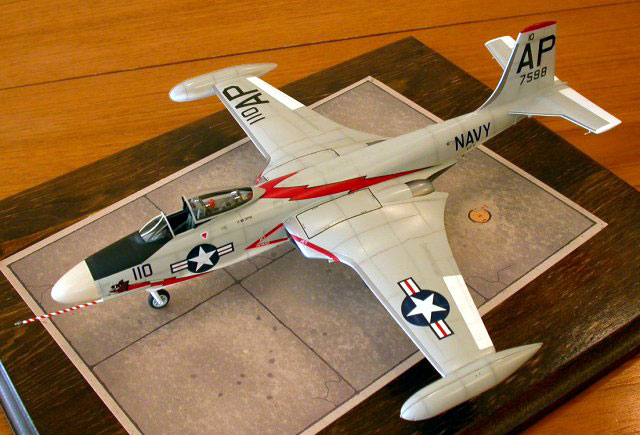
|
|
F2H-4 Banshee |

HyperScale is proudly supported by
Squadron.com
The F2H-3/4 Big Banshee was the natural state of evolution for the
small Banshee F2H-2 and the smaller FH-1 Phantom.
The first F2H-3 flew on March 1952.
Inside its 8 foot longer fuselage it housed more internal fuel (over
1100 gallons) and a bigger Westinghouse AN/APQ-41 radar (the -4 had a
Hughes radar).
The bigger fuselage housed 4 20mm canons and the bigger wings offered
space for 8 weapons racks that could carry bombs or HVAR/HPAG rockets.
More importantly the Big Banshee could carry a nuclear weapon under the
port wing making the Big Banshee the first nuclear capable US Navy jet
fighter. Later, the Big Banshee was made capable of carrying two
sidewinders under the wings.
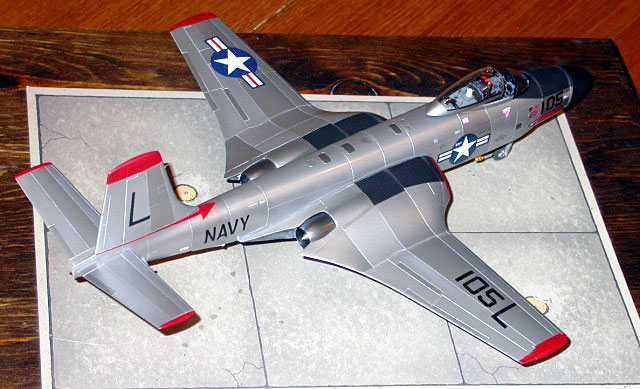
The US Navy received its last of the 250 F2H-3s and 150 F2H-4s in
November of 1953. The Big Banshee served with reserve units until 1961.
In 1955 Canada received F2H-3s for the Royal Canadian Navy. When
Canada discontinued its carrier operation (Bonadventure) in 1959 it
gradually phased out the Banshees.
Visually the F2H-3 did not differ from the F2H-4. There was different
equipment that found its way on both variants such as different radars,
different engines, tailplane leading edge extensions, an air refueling
probe that replaced the upper port cannon and a belly fuel tank.
Most of the early Big Banshees were produced in anodized natural
metal but their skins did not take the abuse of the environment they
were exposed to very well. Some early Big Banshees can also be seen in
Dark Sea Blue. In the mid 1950's they were repainted to the standard
gray/white navy scheme.
Collect-Aire
Resin's 1/48 Scale Banshee
|
The Big Banshee was a long range all-weather multimission fighter
with the latest radar and fire control system of its time. Yet it has
been ignored by the mainstream model manufactures and no injected kit of
it presently exists in 48th scale.
Some years ago Collect-Aire made a resin kit of the Big Banshee By
virtue of being the only 48th scale kit of this plane it was defacto the
best kit too. In reallity, it had some big dimensional issues and
Collect-Aire discontinued it. The model was redone from scratch by their
top maker who did an exemplary job with capturing the look and
dimensions of this plane. It certainly helps that he has aerospace
background but what maters in modelmaking is the ability and talent to
go beyond the plans and be able to understand the photographic evidence
provided. This is what a good modelmaker is all about. It is art as well
as science. If you have "the eye" you can make a good model, period.
Enough philosophy, let's get on with the kit.
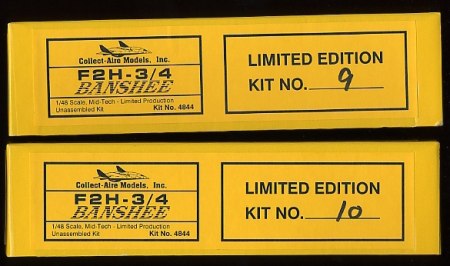
When found out who the maker was for the Big Banshee I promptly
ordered two kits sight unseen and price be damned. There cannot be a
serious US Navy plane collection without the Big Banjo in it.
There was no disappointment. The resin looked good and the plane felt
"right" in the box. If you have seen the Loon Models resin then you know
the resin and molding quality you would find in this kit as well. By the
way, another splendid modeling example of this model maker and resin
shop is the B-66 Destroyer which I cannot say enough good things about.
I had decided to do a dual build again. All the parts were washed
with strong detergent and warm water to get rid of the mold release
agent. Cleanup of the parts was pretty fast and easy. Test fiting showed
that there was some shrinkage of the part representing the lower middle
wing component. It is a solid piece and it appears that while this resin
behaves superbly on the thin parts, it shrinks a little when they are a
bit chunky. I am still thinking it is a better resin formula than the
old one this resin shop used in the past.
I am including here some images from the one Banshee that had the
wing middle section problem more prevalent. Not very difficult to fix.
The other Banshee was much better in that same area.
The cockpit is fine and a nicely detailed rear deck is provided. The
instrument panel is good and cockpit tub is reasonably good. The
ejection seat is ok but you might want to thin out the ejection seat
rail guides. As it is the ejection seat will not fit in the tub.
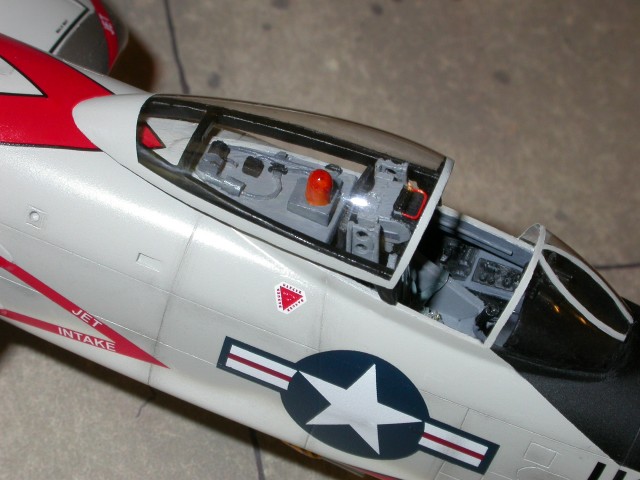
The assembly of the model was easy and follows the same convention as
if building an injected kit. I found it easier to completely assemble
the wings and mate them to the joined fuselage. Despite the differential
shrinkage between fuselage and wings I was happy to discover that the
wing fuselage joint was very clean on the top side and that it needed
very little attention. Kudos to the maker on this one. The model is nose
heavy and no extra weight is required. I liked the intakes and exhausts
treatment with fan blades located at the proper depth. Spend a little
time cleaning the intakes because the molding process leaves some work
for the modeler to do. One more thng I chose to do is insert styrene
stock as a sandwich between the fueltank halves. I then used a file to
shape it and bring it really close to the contours of the tank. You can
see this strip of metal showing all around the wing tip tanks in the
provided walkaround.
I chose to make my two Big Banshees as different as possible. I
wanted to make an early F2H-3 in natural anodized metal with plank style
tail wings and with a clean body from extra features.
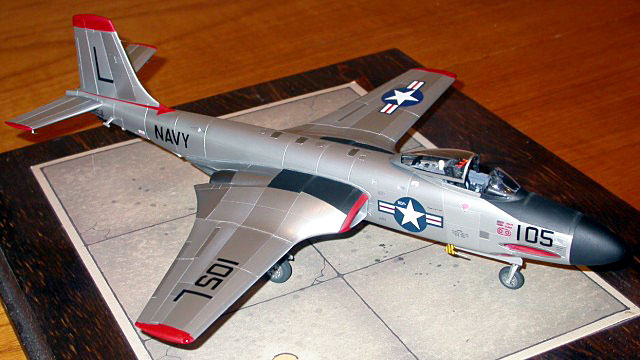
The kit gives decal options for two gray/white US Navy birds and also
two Canadian planes. I had to make my own VF-73 decals and paint the red
markings myself. I used the Ginter book for the profile and some nice
color and black & white photos that showed the multi hue polished
natural metal to great effect. By the way, the early Big Banshees were
not aluminum lacquer but natural metal instead.
For my F2H-4 I wanted it to look more busy than the -3. I used the
refueling probe option, the external hard points, the belly and wingtip
fuel tanks and left the tail wings alone. I chose to use the kit decals
representing a VF-11 bird. I used for reference a nice black&white photo
of this plane at a later stage of its life in one of the older Squadron
Signal books.
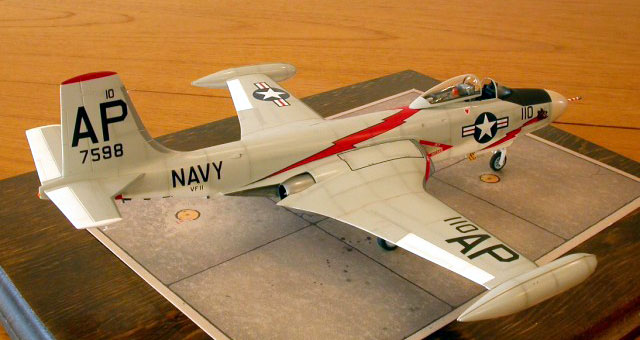
The decals (printed by MPD) are much better in quality than their old
style that was present in the original Big Banshee Collect-Aire kit.
They are very thin so be carefull when you move them to position. I used
only warm water and after they had mostly set I used some MicroSet to
make them fit a bit better on the compound curves. Chrysler Engine Red
by Testors is a close match to the red of the decals. You might need
some to fill-in those areas like the gun ports were the decals will not
provide adequate coverage.
I ended up with two distinctly different Big Banjos and I am happy
enough to have them in my collection. Maybe one day we will have an
injected Big Banshee and I can then make a Canadian as well but such a
day is probably in the distant future. (I am aware of the AMTech
announcement but I would rather see it in the flesh)
The artwork is provided by my aspiring aviation artist wife who took
a liking to the natural metal Banshee. She has more aviation art at:
www.rouchworks.com
Click on the thumbnails
below to view larger images:
Model, Images and Text Copyright © 2003 by
Fotios Rouch
Page Created 29 December, 2003
Last Updated 17 March, 2004
Back to HyperScale
Main Page
|
Home |
What's New |
Features |
Gallery |
Reviews |
Reference |
Forum |
Search